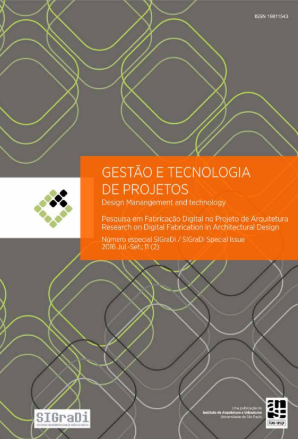Bone-inspired 3D printed structures for construction applications
DOI:
https://doi.org/10.11606/gtp.v14i1.148496Palavras-chave:
Functionally Graded Trabecular Tectonics, Digital fabrication, Additive manufacturing, Computational design, BiomimeticsResumo
Overconsumption of resources is one of the greatest challenges of our century. The amount of material that is being extracted, harvested and consumed in the last decades is increasing tremendously. Building with new manufacturing technology, such as 3D Printing, is offering new perspectives in the way material is utilized sustainably within a construction. This paper describes a study on how to use Additive Manufacturing to support design logics inspired by the bone microstructure, in order to build materially efficient architecture. A process which entangles computational design methods, testing of 3D printed specimens, developments of prototypes is described. A cellular-based tectonic system with the capacity to vary and adapt to different loading conditions is presented as a viable approach to a material-efficient construction with Additive Manufacturing.
Downloads
Referências
Ashby, M.F., Evans, A.G., Fleck, N.A., Hutchinson, J.W., Gibson, L.J. & Wadley, H. (2000). Metal foams - a design guide, Vol. 1, Butterworth-Heinemann.
Bendsøe, M. P. & Sigmund, O. (2003). Topology Optimization: Theory, Methods and Application, Berlin, Springer.
Benyus, J. M. (2002). Biomimicry. Innovation inspired by nature, HarperCollins Publishers, NYS.
Hooke, R. C. (1665). Micrographia: or Some Physiological Descriptions of Miniature Bodies Made by Magnifying Glasses. London, England: Jo. Martyn, and Ja. Allestree.
Lim, J. (2009) Bio-Structural Analogues in Architecture. BIS publishers.
Naboni, R., Kunic, A. & Paoletti, I. (2016). Load-responsive skin systems for lightweight architecture. Proceedings of 11th Conference on Advanced Building Skins. Bern, Switzerland. October 2016.
Naboni, R., Kunic, A., Breseghello, L. and Paoletti, I. (2017). Load-Responsive Cellular Envelopes with Additive Manufacturing. Journal of Facade Design and Engineering. Vol. 5, Special issue Powerskin. November 2017. Pp. 37-49.
Thompson, D’Arcy W. (1945) On Growth and Form . University Press, Macmillan in Cambridge, New York.
Turner, J.S. (2012) Evolutionary architecture. Some perspectives from biological design, In AD, Architectural Design: Material Computation, No. 216, March/April 2012, pp. 28-33.
Downloads
Publicado
Edição
Seção
Licença
Autores que publicam nesta revista concordam com os seguintes termos:
- Autores mantém os direitos autorais e concedem à revista o direito de primeira publicação, com o trabalho simultaneamente licenciado sob a Licença Creative Commons Attribution-NonCommercial-NoDerivatives 4.0 que permite o compartilhamento do trabalho com reconhecimento da autoria e publicação inicial nesta revista.
- Autores têm autorização para assumir contratos adicionais separadamente, para distribuição não-exclusiva da versão do trabalho publicada nesta revista (ex.: publicar em repositório institucional ou como capítulo de livro), com reconhecimento de autoria e publicação inicial nesta revista.
- Autores têm permissão e são estimulados a publicar e distribuir seu trabalho online (ex.: em repositórios institucionais ou na sua página pessoal) a qualquer ponto antes ou durante o processo editorial, já que isso pode gerar alterações produtivas, bem como aumentar o impacto e a citação do trabalho publicado (Veja O Efeito do Acesso Livre).







